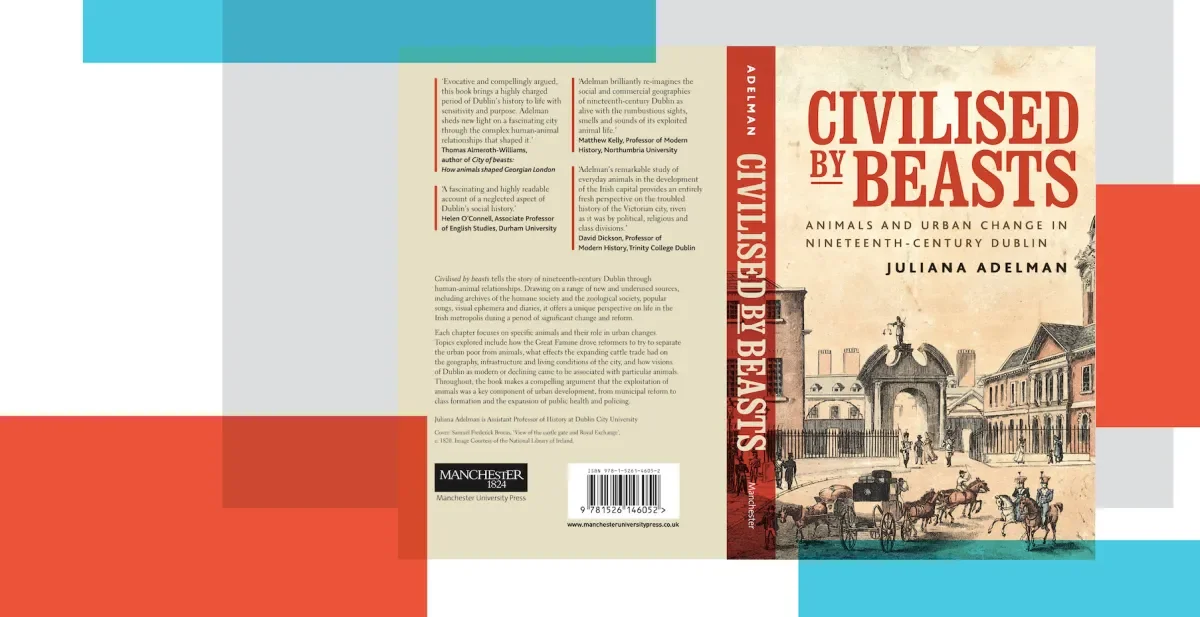

Civilised by beasts – the role of Ireland’s animals in urban change
Civilised by beasts is a book that will appeal to anyone fascinated by the history of cities, the history of Dublin or the history of Ireland. Recently launched by Manchester University Press, this unique book covers a period of significant change and reform in Ireland from 1830 to 1900, with each chapter focusing on specific animals and their relationship to urban changes. As Dr Juliana Adelman described recently on RTE Radio One’s Today with Claire Byrne, her aim was to “bring back animals into our sense of history”.
A new way of telling history
Civilised by beasts tells the story of the changing city through the development of its zoological gardens, the regulation of urban pig farming, the building of a new cattle market and a growing enthusiasm for pedigree dogs.
Dr Adelman, author and lecturer with our School of History and Geography, said: “This book is a totally new way of looking at the history of Dublin in a city that still shows the traces of its animal past. Animals are so important to consider when we look at how traditionally considered human spaces like cities have changed. We are living through a pandemic of an illness that moved from animals to people in a city so it is about time we stopped thinking that humans, and the places we live, are somehow apart from the rest of nature.”
Pigs in the back garden
At the heart of this book is the argument that the exploitation of animals formed a key component of urban change, from municipal reform to class formation to the expansion of public health and policing.
She continued: “In 19th century Dublin it was very common to see people driving cattle down the streets of Dublin on their way to slaughter. People kept pigs in the back garden or in the house or even in a tenement – to have a piggy savings bank. This way of living had implications for public health, and animal welfare.”
How we became civilised by beasts
According to Dr Adelman we became “civilised by beasts” because those involved in reforming the city wanted to reduce what they saw as the negative consequences of the animal economy on the city. They didn’t want people to see the violence of slaughter or to smell overflowing manure heaps or to catch animal-borne diseases.
The emergence of pets
The book shows how reformers sought to reduce the impact of animals that were kept for economic reasons as a source of meat or transport in 19th century Dublin, while the keeping of pets became the preserve of a wealthier, middle class. The police clamped down on roving dogs while Dubliners flocked to dog shows and paid extra for pedigree breeds.
Contrasting the rise of pets during Covid
News reports on the increased demand for pets in Ireland during Covid lockdown restrictions is one for future history books. Earlier this month, Dublin’s Society for the Prevention of Cruelty to Animals (DSPCA) reported that puppy prices have gone through the roof due to increased demand with more people suddenly working from home in line with government health advice. The form of animal cruelty has also changed as the DSPCA warned that of approximately 70,000 puppies born in Ireland annually, half of these come from puppy farms.
Dublin Zoo now and then
The establishment of Dublin Zoo in 1831 was a significant initiative to promote the city and promote good relations between people of different classes. Almost 200 years since it first opened its doors, Dublin Zoo launched an urgent public fundraising appeal to care for its 400 animals during Covid lockdown restrictions to avoid permanent closure. Once again, almost two centuries on, this iconic attraction united people from all over Ireland as it raised €1.2m in a matter of hours.
Dr Adelman said: “Dublin Zoo was a celebrated space that showed Dublin was as good as London and Paris. It was an attraction that attempted to reconcile differences between the elite and people of lower social classes. But like Dublin Zoo now, it struggled with money as well because keeping animals is expensive. However, treatment of the animals was very different in the 19th century, animals lived in a confined space in cages where they were poked and prodded by the public.”
Acknowledgements
Thanks to the Irish Research Council which funded early postdoctoral research by Dr Juliana Adelman. Thanks also to Manchester University Press for publishing this great book.
Reviews
Dr Adelman’s book is described ‘as the remarkable study of everyday animals in the development of the Irish capital’. Read more reviews here.
